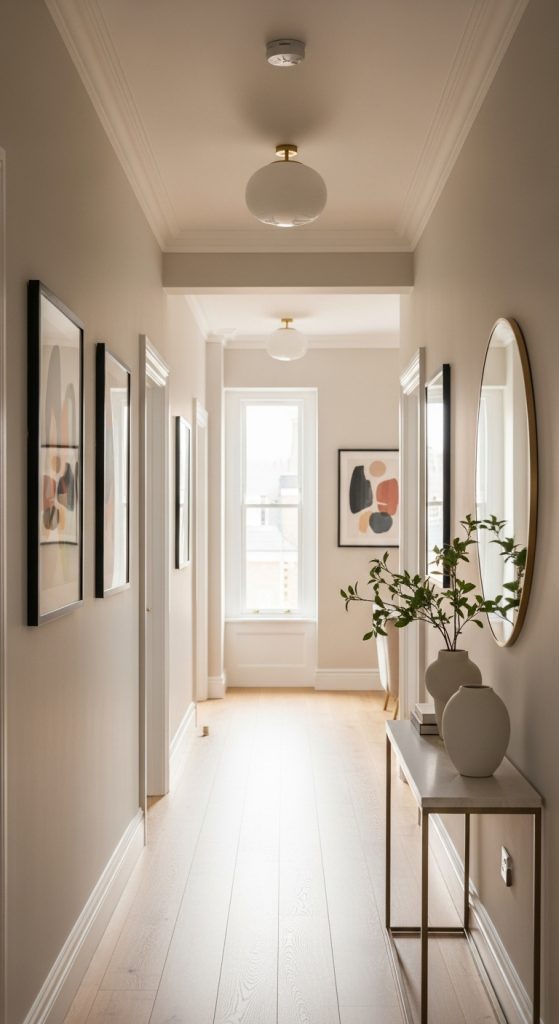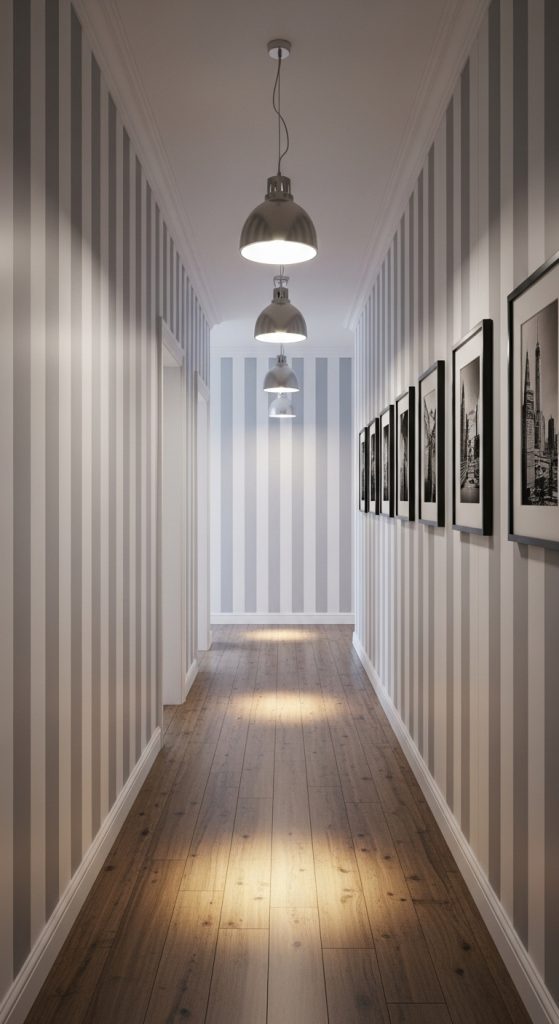A hallway is often the most overlooked space in a home, yet it plays a vital role in setting the tone for your interior design. Since hallways are transitional spaces that connect different areas, painting them creatively can completely transform your home’s atmosphere. Whether you want a warm and inviting tone, a bold artistic statement, or a calm minimalist style, the right paint and preparation can make all the difference. This detailed guide explores ten unique hallway painting ideas, including materials, preparation, and execution, to help you achieve a beautiful and lasting result.
1. Classic Neutral Hallway
A neutral hallway creates an elegant and timeless backdrop for any home style. Shades like beige, taupe, ivory, and light gray can make narrow spaces appear more open and calm. Begin preparation by cleaning the walls thoroughly with a mild detergent to remove dust and grease. Fill any nail holes or cracks with spackling paste and sand the surface smooth once dry. Apply painter’s tape to protect trim and ceilings before you start.
Use a high-quality primer, especially if you’re covering a darker color. Choose an eggshell or satin finish for easy cleaning and subtle sheen. Neutral walls pair beautifully with framed artwork, wooden floors, or metal accents. Lighting also enhances these tones; use warm light bulbs for a cozy look. Neutrals allow flexibility when changing decor, and they work well with both modern and traditional interiors. This color palette creates a peaceful transition between rooms and gives your hallway an effortlessly refined charm.

2. Bold Accent Wall
A bold accent wall adds personality to your hallway without overwhelming the space. Choose one main wall—typically the one at the end of the hallway or one with architectural features—to apply a striking color like navy blue, emerald green, or charcoal gray. Preparation includes cleaning the wall and applying painter’s tape to ensure crisp edges. A high-quality primer is essential when using rich or dark colors to prevent uneven coverage.
Use a semi-gloss or satin finish to reflect light subtly and make the space feel lively. Pair the bold wall with lighter surrounding walls to maintain balance. For example, if the accent wall is navy blue, keep the rest of the hallway a soft gray or white. Decorate with artwork or mirrors to add dimension and draw the eye forward.
Accent walls make narrow hallways appear more dynamic and give a sense of direction. This approach works particularly well in contemporary homes where color contrast enhances architectural features. The key is restraint—one bold wall can make a greater impact than multiple competing hues.

3. Two-Tone Wall Design
Two-tone wall painting adds depth and character to hallways. This design typically divides the wall horizontally, using one color on the upper section and another on the lower section. To prepare, measure and mark a straight horizontal line using a level and painter’s tape. Clean and prime the walls before painting.
Choose complementary colors for balance. For example, pair white with sage green, or light gray with navy. Paint the lighter shade first, allow it to dry completely, then carefully apply the darker shade below. The lower portion often benefits from a satin finish for durability, while the upper can use matte for a soft texture.
Two-tone walls are ideal for long hallways as they visually break up the space and add architectural interest. Adding molding or chair rail trim between the colors enhances definition. This design blends functionality and style, giving the illusion of height and structure. It’s an excellent way to make hallways more sophisticated without relying on heavy decor.

4. Pastel-Themed Hallway
Pastel tones bring freshness and serenity to hallways, making them ideal for homes that emphasize light and openness. Soft shades like mint green, powder blue, lavender, and blush pink can make even the smallest corridors feel inviting. Start preparation by removing dust and repairing imperfections with filler. A light sanding helps ensure smooth paint application.
Choose water-based paint for easy cleanup and low odor. Pastels work best in natural light, so consider their placement near windows or bright fixtures. Apply two coats for even coverage, allowing proper drying time between layers. To complement the soft tones, add white trim and light wooden flooring for a balanced look.
Pastel hallways pair beautifully with modern or Scandinavian-style interiors, where simplicity and brightness are key. They also make great backgrounds for minimalist artwork or decorative mirrors. The gentle hues evoke calmness and positivity, transforming an ordinary hallway into a cheerful, airy passage that connects your home seamlessly.

5. Striped Hallway Walls
Stripes add rhythm and energy to hallways, making them appear longer or taller depending on the orientation. Vertical stripes make ceilings seem higher, while horizontal stripes expand the visual width of narrow corridors. Preparation is key—measure the wall carefully and use a laser level or chalk line to ensure straight, even stripes. Apply painter’s tape to define each stripe before painting.
Select two or three complementary colors for the best effect. A subtle contrast like white and beige creates elegance, while bolder pairings like black and white make a dramatic statement. Paint the base color first and allow it to dry completely before adding the second color. Remove the tape carefully while the paint is still slightly wet for clean lines.
Stripes add a playful yet sophisticated design element, suitable for both modern and traditional homes. They can also be used to emphasize architectural details like arches or niches. This painting technique offers endless creativity and helps personalize an otherwise overlooked space.

6. Dark and Dramatic Hallway
Contrary to common belief, dark colors can make a hallway feel luxurious and intimate. Shades like charcoal gray, forest green, or deep navy add sophistication and depth. Begin by cleaning and priming the walls to ensure even coverage, as dark paint highlights imperfections more easily.
Use a roller with a fine nap for smooth application and choose high-quality paint with rich pigment. Satin or matte finishes work best to avoid excessive shine. Balance the dark tones with good lighting—install wall sconces or LED strips to keep the space inviting. Pairing dark walls with white trim or metallic accents enhances contrast and elegance.
Dark hallways work beautifully in modern or industrial-style homes. They create a sense of drama and can turn a simple corridor into a statement area. Adding mirrors or light-colored flooring prevents the space from feeling enclosed. This idea works especially well in well-lit homes or areas that connect to bright rooms, creating an appealing visual balance.

7. Monochromatic Theme
A monochromatic hallway uses variations of a single color to create a cohesive and sophisticated look. For example, shades of gray ranging from light silver to charcoal can add subtle elegance. Preparation involves cleaning and sanding the walls to achieve a smooth surface. Priming is recommended if the existing color contrasts sharply with your chosen hue.
Choose three tones of the same color: light for the upper walls, medium for the lower section, and dark for accents such as doors or trim. This layering of tones provides depth without overwhelming the space. Use a satin or eggshell finish for easy maintenance.
Monochromatic designs are ideal for minimalist homes where harmony and continuity are key. They create a visual flow between rooms and can be enhanced with matching decor elements like rugs or artwork. This concept adds refinement and tranquility, turning a simple hallway into a seamless design statement that ties your entire interior together.

8. Textured Paint or Faux Finish
Adding texture or a faux finish gives your hallway a luxurious and artistic touch. Preparation is crucial: clean the walls, fill imperfections, and apply primer for even adhesion. Choose a paint technique such as sponging, rag rolling, or Venetian plaster depending on your desired effect.
Textured paints create depth and dimension, making plain walls come alive. For example, a faux marble finish adds sophistication, while a subtle brushed metallic look introduces elegance. Use tools like sea sponges or soft cloths to achieve the desired pattern. Work in small sections and blend carefully for uniform results.
Faux finishes suit traditional and contemporary interiors alike. They are durable and hide minor wall imperfections. Pair textured walls with simple furniture and lighting to let the finish stand out. This approach transforms hallways into visually rich spaces that reflect creativity and craftsmanship while maintaining functionality.

9. Geometric or Patterned Walls
Geometric patterns are perfect for adding modern flair to hallways. Preparation includes marking out the design using painter’s tape and measuring tools. Patterns like triangles, chevrons, or hexagons can be created with different color combinations. Ensure the wall is clean and primed before painting.
Choose contrasting shades to make the design pop. For example, use white and mustard for a bold statement or soft gray and pastel pink for a more subtle effect. Apply paint with precision and remove tape before the paint dries completely to maintain clean edges.
Patterned walls work best in wider hallways or areas with minimal decor. They add energy and personality to otherwise plain spaces. Geometric painting allows endless customization and can complement modern, eclectic, or industrial interiors. When executed neatly, these designs turn hallways into stunning art-like transitions between rooms.

10. White and Bright Hallway
A white hallway is timeless, versatile, and makes spaces appear larger and brighter. Preparation involves thorough cleaning and applying a primer to ensure uniform color. Choose high-quality white paint with subtle undertones—warm whites create coziness, while cool whites feel crisp and modern.
Apply two coats using a roller for smooth coverage. Satin or eggshell finishes are ideal for hallways since they resist scuffs and are easy to clean. Add character with contrasting black or wooden trim. Mirrors, metallic light fixtures, and colorful artwork can break up the monotony and enhance brightness.
A white hallway suits every home style—from farmhouse to minimalist. It reflects light beautifully, making it ideal for areas with little natural light. This approach creates a fresh, airy feel that complements any decor. White paint acts as a blank canvas, allowing decorative elements and architectural details to shine.

